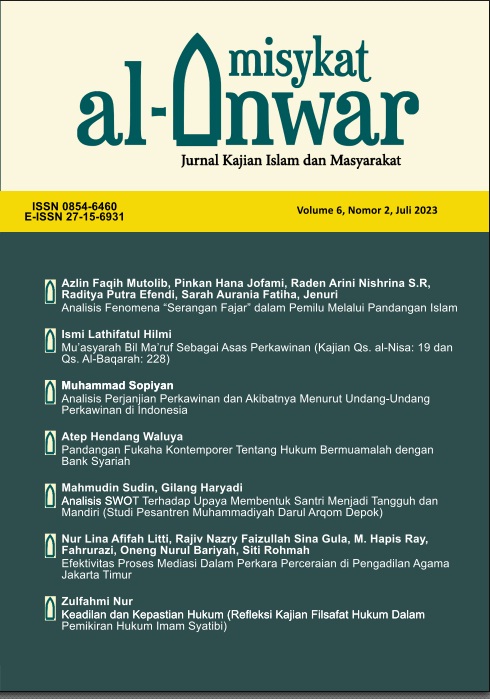ANALISIS PERJANJIAN PERKAWINAN DAN AKIBATNYA MENURUT UNDANG-UNDANG PERKAWINAN DI INDONESIA
Main Article Content
Abstract
Article Details
All manuscripts published in the Misykat al-Anwar Journal of Islamic Studies and Society are entirely the property of the author, as for the entry and unpublished script of the journal, the copyright is wholly the property of the author.
All manuscripts published in the Misykat al-Anwar Journal of Islamic Studies and Society are open to the public by following the provisions of the CC-BY-NC-SA (Attribution Non Commercial Share Alike) platform where everyone is allowed and permitted to adapt, the results of the study with the provision should provide citation credit to the author (citation) not for commercial purposes, and one must make a similar provision to the results of his research.
---
Semua naskah yang diterbitkan dalam Misykat al-Anwar Jurnal Kajian Islam dan Masyarakat sepenuhnya menjadi hak milik penulis, adapun naskah yang masuk dan belum diterbitkan oleh jurnal, hak cipta sepenuhnya milik penulis.
Semua naskah yang diterbitkan dalam Misykat al-Anwar Jurnal Kajian Islam dan Masyarakat terbuka untuk umum (open access) dengan mengikuti ketentuan platform CC-BY-NC-SA (Attribution Non Commercial Share Alike) semua orang diperbolehkan untuk menyadur, merujuk dan mengadaptasi tulisan/hasil penelitian dengan ketentuan harus memberikan kredit rujukan kepada penulis (citation) bukan untuk kepentingan komersial, dan seseorang harus melakukan ketentuan yang serupa terhadap hasil penelitiannya.
References
Amiruddin and Zainal Asikin, (2020) Pengantar Metode Penelitian Hukum, Ed.
Revisi. Depok: Rajawali Press
Djais, Mochamad. (2008) .Hukum Harta Kekayaan dalam Perkawinan.
Semarang: Fakultas Hukum Universitas Diponegoro,
Muchsin. (2008). Perjanjian Perkawinan dalam Perspektif Hukum Nasional.
Jakarta: Varia Peradilan,
Mulono, Martias Gelar Imam Radjo. (1982). Penjelasan Istilah-Istilah Hukum
Belanda Indonesia. Jakarta: Ghalia,
Mulyadi. (2008). Hukum Perkawinan Indonesia.. Semarang: Badan Penerbit
Universitas Diponegoro. Cetakan Pertama
Prawirohamidjojo, Soetojo. (1986). Pluralisme dalam Perundang-Undangan
Perkawinan di Indonesia. Surabaya: Airlangga University Press,
___________dan Marthalena Pohan. (2000). Hukum Orang dan Keluarga.
Surabaya: Airlangga University Press,
Saleh, K. Wantjik. (1982). Hukum Perkawinan Indonesia. Jakarta: Ghalia
Indonesia,
Ardhya, Si Ngurah dan I Putu Windu Mertha Sujana. (2021). “Konsekuensi
Yuridis Berlakunya Perjanjian Perkawinan Pasca Putusan Mahkamah
Konstitusi Nomor 69/PUU-XIII/2015”. Jurnal Komunikasi Hukum Vol. 7
No. 1
Arief, Hanafi. (2017). “Perjanjian dalam Perkawinan (Sebuah Telaah Terhadap
Hukum Positif di Indonesia)”. Jurnal Al’Adl Vol IX No.2 .
Dwinopanti, Eva. (2017). “Implikasi dan Akibat Hukum Putusan Mahkamah
Konstitusi Nomor 69/PUU-XIII/2015 terhadap Pembuatan Akta Perjanjian
Perkawinan Setelah Kawin yang Dibuat di Hadapan Notaris”. Lex
Renaissance Vol.2 No.1
Sutikno, Gusti Muhammad Faruq Abdul Hakim. (2018). “Kekuatan Hukum
Pencatatan Perjanjian Perkawinan Bagi Para Pihak”. Jurnal Privat Law
Vol. VI No. 2.
R. Subekti dan R. Tjitrosudibio. (2008). Kitab Undang-Undang Hukum Perdata
[Burgerlijk Wetboek voor Indonesie]. Diterjemahkan oleh. Jakarta:
Pradnya Paramita,.
Indonesia. Undang-Undang Peraturan Dasar Pokok-Pokok Agraria. UU Nomor 5
Tahun 1960. Lembar Negara Nomor 104 Tahun 1960. Tambahan Lembar
Negara Nomor 2043.
Indonesia. Undang-Undang Perkawinan, UU Nomor 1 Tahun 1974. Lembar
Negara Nomor 1 Tahun 1974. Tambahan Lembar Negara Nomor 3019.
Indonesia. Undang-Undang Jabatan Notaris. UU Nomor 30 Tahun 2004. LN No.
Tahun 2004. TLN No. 4432.
Indonesia. Undang-Undang Penanaman Modal. UU No. 25 Tahun 2007. LN No.
Tahun 2007. TLN No. 4724
Indonesia. Undang-Undang Perubahan atas Undang-Undang Nomor 30 Tahun
tentang Jabatan Notaris. UU Nomor 2 Tahun 2014. LN No. 3 Tahun
TLN No. 5491.
Peraturan Pemerintah Nomor 9 Tahun 1975 tentang Pelaksanaan Undang-Undang
Nomor 1 Tahun 1974 tentang Perkawinan. LN No. 12 Tahun 1975. TLN
No. 3050.
Putusan Mahkamah Konstitusi Republik Indonesia. Putusan Nomor 69/PUU-
XIII/2015.
